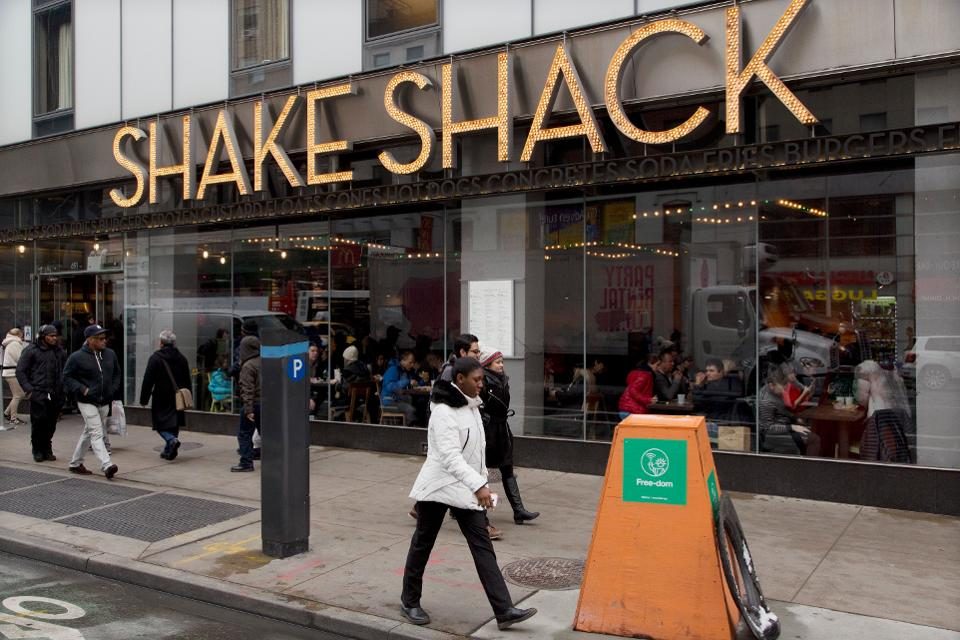Shake Shack is one of the winners in the decade since the Great Recession. (AP Photo/Mark Lennihan, File)
You might think restaurants are struggling, given the number of famous and franchised places that have closed lately. In fact, the industry itself has fared well since the Great Recession.
But, some key things are different, according to the trade publication Restaurant Business.Jonathan Maze, RB’s executive editor, looked at 10 ways restaurants have changed since the economy tanked in 2008 and 2009.
In his story, Maze says the recession provided a “reset” for the restaurant industry. It was a dismal period for food places, because consumers of all income levels cut back on how often they ate out, and what they spent when they did dine out.
Of the 10 trends, three money-related ones jumped out at me, reflecting both the ways consumers spend their money, and what they want from restaurants now.
1. Restaurant spending is up
Last year, Americans spent a projected $799 billion in restaurants, according to an estimate by the National Restaurant Association. That’s an increase of 36% since 2010. In fact, the financial pinch of the recession wasn’t felt immediately.
In 2009, Forbes reported that of all the categories in the economy, restaurant spending was the only one to rise in 2008, versus 2007. It felt the economic pinch a little later because people still went out to eat, even as the value of homes declined and jobs disappeared.
Back in 2008, restaurants took 40% of American’s discretionary spending, according to a survey by Spending Pulse, the economic research arm of MasterCard Worldwide. But interestingly, the survey found that spending in the fourth quarter of 2008 was dominated by fast-food purchases, not sit-down restaurants, a sign of the drop to come.
2. Restaurants are a bigger chunk of the economy
Restaurant Business reports that restaurants have added more than two million jobs since 2008, and now employ 11.8 million people. The percentage of people in the economy whose work is restaurant derived is now 8%, compared with 6.7% in 2008.
The country has many more restaurants than 10 years ago. The number of eating places has grown by 16%, to 630,000, compared with 2008.
But, restaurants across the country are reporting problems in finding people to fill jobs, especially in kitchens. Experts blame low wages, long hours and the many alternatives to restaurant kitchens, such as gourmet delis and grocery stores.
In June, the New Orleans Times-Picayune reported that restaurants there are “desperate for staff.” Training programs are popping up in order to groom future cooks and chefs, according to Eater.
3. Fast casual is up, casual is stumbling
A decade ago, only 7% of U.S. restaurants fell under the “fast casual” label—places with individually prepared dishes that customers ordered at a counter. Think Shake Shack, Panera Bread and Blaze Pizza.
In 2017, fast casual accounted for 13% of all restaurants. Considering that the number of restaurants has grown, that is a lot of fast casual places.
Casual dining restaurants, where you sit down at a table and place an order, grew in the past 10 years. The number of units was up 1.6%, while sales revenue grew 2.3%. However, they’ve lately taken a hit as major national chains have shut outlets and even closed down entire brands. Among the nation’s top 500 restaurant chains, the number of restaurants fell by 1.5% in the past year, Restaurant Business said.
Beyond the financial shifts, other things are clear about the past decade in the food world. Restaurants are embracing new technology, like the self-ordering kiosks that McDonald’s plans to have in all its U.S. stores by 2020. Food places are responding quickly to changes in attitudes, like Starbucks’ decision to phase out plastic straws. And flavors, like tahini and za’atar spice, are leaping from specific cuisines to broader acceptance. They’re also copying other successful categories, like craft beer, to introduce new ways of serving coffee.
Having weathered the past ten years of change, restaurants can only expect more.

